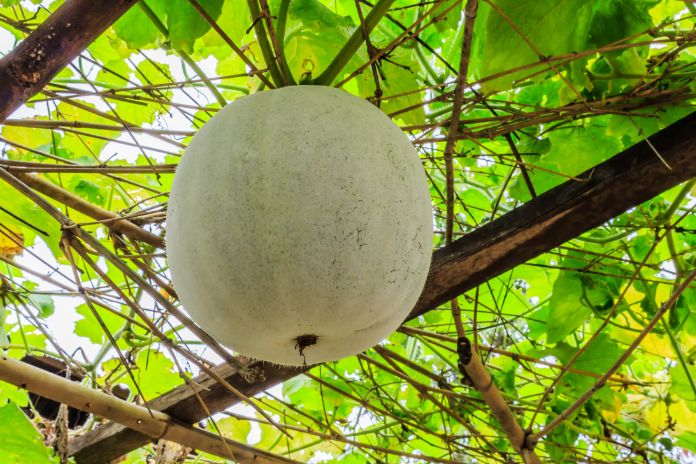Scientifically known as Benincasa hispid, the winter melon is a substantially sized fruit that grows on a vine and is consumed as a vegetable upon full maturity. It is interesting to know that this fruit; known by many names like the ash gourd, wax gourd, white gourd, ash pumpkin, winter gourd, Chinese preserving melon, and tallow gourd to name a few; is the only member of its genus, i.e., Benincasa.
When young, the fruit has fine, fuzzy hairs all over it. However, when it totally matures, a waxy layer is produced, giving it much more resistance against rot. At this stage, the winter melon typically grows to around 79 to 80 centimeters in length, with wide leaves and yellow flowers.
Nutritional composition
There are quite a few health benefits of the winter melon, which is backed by its nutritional components. One 100-g portion of winter melon has:
- Protein: <1 g
- Fiber: 3 g
- Vitamin c: 14% of the daily value (DV)
- Calories: 13
- Fat: <1 g
- Carbohydrates: 3 g
- Riboflavin: 8% of the DV
Along with these main constituents, winter melon has several b vitamins. It also has tiny amounts of manganese, iron, copper, magnesium, and phosphorus, all of which are within 3% of their respective DVS. Antioxidants are also high in winter melons, making them more beneficial.
5 health benefits of winter melon
A lot has been said about the health benefits of the winter melon, and there are indeed a fair few. Here are 5 health benefits of the winter melon:
Can reduce inflammation
Research has shown that extracts from the winter melon can reduce inflammation. Inflammation is, of course, a key reason for many chronic conditions.
Can have antimicrobial effects
Analyses have shown that winter melon extracts can offer protection against specific types of fungi and bacteria.
Can prevent ulcers
Specific to certain animals such as rats, the winter melon has been seen to prevent the occurrence of ulcers in the stomach.
Can protect against type-2 diabetes
The aforementioned nutritional properties of the winter melon can assist in preventing diabetes. It also helps in lowering insulin, triglyceride, and blood sugar levels.
Can enhance digestion
As the winter melon has high levels of water and fiber, and low amounts of calories and sugar, it is certainly equipped to better our digestion and drive weight loss. Studies have shown that water-dense foods with low calories can help with weight loss. In addition, winter melons are a good source of soluble fiber, the kind of fiber that creates a gelatinous substance in our gut, slowing digestion and inducing fullness. Its carb content is quite low as well, making it a great addition to any low-carb diet.
How to consume winter melon?
As mentioned before, the winter melon is popular across Asia. Typically, is cut into cubes, boiled, and then added to stews, curries, and yes, soups. It also consumed as tea or juice. Additionally, it can be candied, fried, baked, or just peeled to add to salads. It can also be had raw, exactly like how we have a cucumber.
Because of the sheer number of ways in which it can be prepared, the winter melon can be used in making cakes, jam, ice cream, candy, or ketchup. It is even used in making certain Indian sweets and can be added to smoothies and juices for added flavor.
What does winter melon taste like?
When the winter melon is young, its thick, white contents have a sweet taste. But when it matures completely, its taste becomes somewhat similar to that of cucumber. This makes it an ideal accompaniment in several Indian and Chinese dishes.
Popular winter melon recipes
Here are a couple of popular recipes you can make with the winter melon:
Winter melon stir fry
Ingredients
- 680 g winter melon, peeled and cut into 6x1cm pieces
- 2 tbsp. Papery shrimp
- ½ carrot, cut into 6x1cm pieces
- 1 long green pepper, sliced
- 1 tbsp. Peanut oil
- ½ tsp. Chicken/mushroom powder
- 2 cloves garlic, minced
- ¼ tsp. Salt
- 1 tsp. Sugar
- 1 tsp. Water for the slurry
- ½ tsp. Cornstarch for the slurry
Method
- Mix the cornstarch and water for the slurry and keep it aside.
- In a large skillet, add 8 cm of water and boil. Add salt and carrots and boil for 1 minute. Add the winter melon and boil for an additional 1-2 minutes. The melon should be somewhat soft but not translucent. Drain and rinse the vegetables with cold water, then drain again and set aside.
- Wipe the skillet clean, then heat the peanut oil at medium until it is hot. Add the shrimp, then stir and cook until it becomes golden in about a minute.
- Add the garlic and stir a couple of times to unlock the smell.
- Then add pepper and keep stirring for a minute or so.
- Add the vegetables from before, along with sugar, salt, and the chicken or mushroom powder. Stir and cook until all is even, and the winter melon is softened more. Stir again to thicken the sauce and dissolve the cornstarch, then pour it over the vegetables. Taste and serve hot.
Chinese winter melon soup
Ingredients
- 680 g winter melon, washed, peeled, deseeded, and cut into 5cm pieces
- 2 cups chicken broth
- ¼ cup ham, diced and cooked
- 4 shitake mushrooms, dried
- 1 green onion, green part only, washed and cut on the diagonal into 2.5cm pieces
- Pepper, to taste
- Salt, to taste
Method
- Have the winter melon pieces in a container of water, and boil. Reduce the flame and let it simmer for around 20 minutes until the pieces are tender.
- Get the mushrooms in a bowl, cover them with cold water, and set them aside for 20 minutes. Squeeze out any extra water afterward.
- Add the mushrooms to the pot, along with the chicken broth, ginger, and ham. Add salt and pepper as well and keep tasting for the right balance.
- Let the whole thing simmer for 20 more minutes. Add the green onion as a garnish and serve piping hot.
Where is it available?
The winter melon typically grows in and around the south and southeast Asia, of which it is a native. In fact, the vegetable can be seen to grow across all of Asia, including Japan and Java in Indonesia, from where the origins of the vegetable have been determined. Chi qua, a variant of the winter melon, is very common in Asian cuisine.
Storage of winter melon
When it comes to storage, there are very few demands made by the winter melon. The best place to store it is in a dry, cool place without moisture. This is because the white powder on its surface tends to become sticky when wet and needs to be washed thoroughly before it is cut open for consumption.
References:













